Overview of TEKON SCADA


Overview of SCADA TEKON system in the framework of import substitution.
In the summer of this year, for 3 days I got acquainted with this SCADA system with the goal of understanding whether it should be used. The patient was examined on the example of his own demo project. Therefore, acquaintance is superficial, not like with OpenSCADA in my first article .
SCADA TECON is used (mainly) by the developers themselves, therefore there is little information “from the fields” about it. If there are comments worked with her - great.
I share the results of the nano-review with the audience of Habr.
I made a virtual machine, installed SCADA, I start it — it doesn’t work (now I don’t remember exactly how it was expressed), butted for half a day, already wanted to spit and forget, but remembered the mention that SCADA uses the FireBird database - it seems to be a problem with the database and swears - looked at the folder where SCADA was installed - there is nothing from FireBird - downloaded the database, installed - SCADA worked. A trifle, but spoils the first impression.
CONTENTS
1. Overview of the video frames of the RUNTIME demo project
- Introduction
- Frames
- Graphics editor
- Dynamic view
- Animators
- Receptors
- Scripts
- Bargraph, scale, point of displacement
- Mnemonic characters, object windows
- XY trend
- FBD Editor
- Fixed patterns
- Graphs
- Event list
- Chronicle of events
- Archival Information
- ACP Example
2. SCADA TEKON Composition Overview
- Main components of SCADA system "TEKON"
- Component manager
- Project Objects
- Graphics editor
- Type library
- General settings
- Users, rights
- Controller Statistics - Events
- Controller Statistics - Statistics
- Optional Components - Slave104 Configuration
- Additional components - Recording to external sources
- Change active user
- Message log
3. Remarkable features
4. Questions on SCADA TECON
1. Overview of the video frames of the RUNTIME demo project
Introduction
Basic information
Frames
Graphic editor
Dynamic representation
Animators
Receptors
Scripts
Bargraph, scale, point of movement
Mnemonics, object windows
XY trend
FBD editor
Fixed templates
Charts
Event list Event
chronicle
Archival information
As you can see in the picture, the archive is kept for:
- technological parameters;
- operator actions;
- technological signaling and chronicle of events;
- hardware events;
- technological events;
- emergency messages (you can generate a protocol at the time of the accident);
- state of the object.
ACP Example
2. SCADA TEKON Composition Overview
Main components of SCADA system "TEKON"
| No. | Name | Short description |
|---|---|---|
| 1 | SCADA system client (SCADA.Client) | Performs functions:
|
| 2 | Gateway for the exchange of information with data sources (SCADA.Server) | It carries out information exchange with data sources and transfers control commands to them, diagnoses the operation and sends information to the archive. |
| 3 | Archive station (SCADA.Archive) | Reception and high-speed recording of information coming from other components of the system (gateway, billing station, etc.) on the computer’s hard drive. |
| 4 | Settlement station (SCADA.Calc) | Performing analytical tasks |
| 5 | View archive. (Arh) | Presentation of information from the archive in a structured form (tables, graphs, reports for printing), RAS function. |
| 6 | OPC DA Server (Scada.OPC) | OPC communication with third-party components |
| 7 | Virtual Controller (SCADA.TAVPLC) | Debugging technological programs created in the TEKON SCADA system. The organization of simulators. |
| 8 | WEB control (WC) | WEB interface, access to archived and operational information. It can be used as an operator station (thin client), remote monitoring station. |
Components communicate using the TCP / IP protocol stack.
Scheme of interaction of components of the SCADA system The
overview is not complete, but only the elements of the SCADA system available in demo mode. When you try to run a license-prohibited application, an error message appears.
Component Manager
The main window for accessing SCADA elements (in RUNTIME and especially when the desktop is hidden) is the “Component Manager” - a stripe window hanging at the top of the center of the screen.
Component Manager Component
Manager with an expanded list of components
Project objects
Project objects are all input / output devices (including gateways, workstations, archive servers). Those. the QL1 object is created, with the properties (or attributes) turned ON, DISABLED, ALARM, OFF, and the graphic element is attached to the QL1 object, and not to specific properties / attributes (the animation of the graphic object should naturally take into account the presence of the corresponding properties of the control object). Moreover, in the properties of the QL1 object, you can specify the "Object Type" (type of graphic object) and simply pull out the QL1 project object on the video frame - the corresponding graphic element will be immediately drawn and automatically linked. The name of the tag is “Brand”.
Project Objects
It is possible to import / export to Excel. For ISa objects, the “Save” parameter is provided - setting it means that the value of the variable will be saved after the controller is rebooted, otherwise the value will correspond to the initial one.
Graphic editor The
graphic editor is an editor of mnemonic diagrams, library animated elements, an editor of ST and FBD logic (SCADA TECON has an integrated soft-logic controller / calculator).
Image Editor
Type Library
A real library - contains sounds, pictures, dynamic and static graphic elements, program modules, gateways, data sources. There is import / export through XML. For example, a dynamic valve element (see the figure above) can be associated with its own settings / configuration window (in RUNTIME). Since there are no tags in SCADA TEKON, there is a technological unit (valve1 valve, pump pump3_22, etc.) and tags are attributes of this technological unit, then a library template is indicated in the project objects for a specific technological unit, therefore a graphic element in the graphics editor it is attached to a technological unit or you can simply pull out a technological unit on the mnemonic diagram and the editor will draw the necessary graphic element (taken from the properties of the technological unit).
Binding a graphic element to a technological unit
General settings
General settings apply to the entire SCADA TECON application.
General settings - graphical editor
General settings - operator mode
General settings - monitors
For computers operating in the control system as operator stations, you can configure several desktops with individual settings. The settings include: the number of monitors of the operator station, dividing the area of each monitor into sections (frames), the task for each frame of the video frame.
General Settings - Labels / Signatures
Often, in a SCADA system, signatures of parameter values of various variables or channels of objects are used in window headers, graphs, as prompts, etc. This section presents the available methods for determining the format of signatures.
General settings - functional keyboard.
To execute keyboard keystroke receptors not only on the main monitor, but also on additional monitors (if installed), you must set the option "Perform keyboard keystroke receptors on additional monitors"
General settings - system variable
B In the case when you need to reuse the same text, you can create a variable with a specific comment and value, which you then add to the video frame or report.
General settings - debugging
General settings - viewing the archive
Users, rights
Access functions
Statistics of controllers - events
Statistics of controllers - statistics
The nodes of the tree "SHLYZ_1" and "GATE_69042" are gateways in terms of SCADA TEKON.
Additional components - Slave104 configuration
Additional components - Recording to external sources
In SCADA TECON, the modification of variables is possible both from the operator interface and from external sources. External sources include:
- IEC 60870-5-104 (slave);
- OPC server;
- Settlement station;
- Inter-lock exchange;
- Data mirror.
By default, writing variables from these sources is not available. To enable recording, you must add the appropriate channels to the table “Recording from external sources” (menu Components \ Additional components).
Change the active user
You don’t need to write anything by hand, select from the list and enter the password. there is a virtual keyboard - can be used with panel PCs with a touch screen.
Message Log Message
Log - General
Message Log - Reading
Message Log - Writing
Message Log - DLL Drivers
Message Log - Events
Message Log - Archives
Message Log - Debugging
3. Noteworthy features
1. Runtime settings allow you to disable Task Manager, keyboard shortcuts such as “ALT + F4”, “CTRL + ALT + DEL”, etc.
2. There is a built-in function for confirming the operator’s actions for changing the value of a variable (set by a checkmark in the element properties)
3. the server and client can be started as services - when installing SCADA TECON you need to check the corresponding boxes
4. The data source can be any device to which the SCADA gateway -system can access to read and / or write data. These include controllers, relay protection terminals, network equipment, uninterruptible power supplies, other devices operating according to one of the supported protocols. The following protocols are currently supported:
- ISACOM protocol (TEKON controllers);
- ModBus Protocol (RTU / ASCII / TCP);
- OPC DA Protocol (Server / Client);
- T4000 protocol (TEKONIK I / O modules);
- SPA-Bus protocol;
- Protocol IEC 60870-5-104 (Master / Slave);
- Protocol IEC 60870-5-103 (Master);
- Protocol IEC 61850-8-1 (Master);
- Gateway Exchange Protocol;
- SNMP protocol
- UPS status monitoring protocol;
- Software core ICORE;
- Data mirror;
- SIRIUS protocol (microprocessor devices Sirius, manufactured by ZAO RADIUS Automatics);
- TSIP protocol (TimeSynch).
5. There is a built-in soft-logic controller (almost like in openSCADA) - you can use it to debug animation, archiving, signaling.
6. TEKON controllers can store the value of a variable during an abnormal shutdown or reboot - just check the corresponding box for the variable (see ISa objects).
7. Variables can be forced (value locking): the SCADA TEKON functionality and the IsaGraf target task allows you to block variables (relevant for production controllers of the TEKON Group of Companies). When performing this operation, writing to this variable is blocked and the user can set the value of the variable independently. Only variables of a simple type (BOOL, INT, etc.) can be blocked. To block the field of a functional block, it is necessary to present it in the technological program as a variable. To perform a blocking operation, it is necessary to select the desired variable and select the "Block Variables" command in the context menu. If the controller is redundant or clustered, then the variable in the master controller is blocked. The list of blocked variables is displayed in the “Blocked variables” additional window.
8. There is a concept of patterns: if the application project uses frequently repeated parts of a program or program modules with the same structure, you can use the mechanism of fixed patterns. A fixed template is created once and its instances can be used an unlimited number of times. For each named object of a fixed template (variable, function block), a blank is created with a mask name containing a substitution element. When creating an instance of a fixed template, its structure is recreated (the location of the blocks and the links between them, numbering) and objects (the substitution element is replaced with the specified one).
9. It is possible to observe the values of variables in RUNTIME: in the process of working with a project, it may be necessary to monitor the states of variables in real time. For this purpose, the TEKON SCADA system uses the Spy tool.
10. Action blanks (receptors in terms of SCADA TECON) have a “screenshot” option.
11. To access an object on a video frame from a script, it is given a unique name in the properties of this object in the "Unique Name" field.
12. Web client (web control in terms of SCADA TECON) on IIS and Silverlight technology.
13. Trends with a very nonsensical settings package:
Trend - appearance in RUNTIME mode. Trend
settings window - view.
Trend settings window - general.
Trend settings window - time axis
Trend settings window - left scale
Window trend settings - right scale
Window trend settings - central scales
Trend settings window - print
Trend settings window - read from archive
14. SCADA TEKON can act as an OPC server (for example, for ACS E). To do this, you must:
- install an OPC server item;
- Configure the list of variables to be given "to the top" in the DANSrvNet4.exe.config file through a text editor;

- close the configuration file, after saving it. After changing the settings, you must restart the OPC server.
- You can change the format of the tag name. This is done in the "Template full tag name" field in the gateway configurator.
15. It is possible to use the GatewayToSQL application to translate the values of variables with a specified period from the TEKON Gateway component to the MS SQL database using SQL queries. The user can configure the period of updating data from the gateway, the period of writing data to the database and the period of cleaning the database table.
16. It is possible to monitor applications on all PCs in the project. On the PCs that we monitor, you must install the application monitor server (preferably in the service mode), and on the PC from which we monitor the application monitor client. The application monitor client communicates with application monitor servers located on different computers. The main monitor window is as follows:
- Computer name - the name of the computer for which information is displayed;
- Монитор запущен? — есть ли доступ к серверу мониторинга приложений. Если доступа нет, то больше никакая информация не отображается
- Имя программы — имя программы, для которой отображается информация;
- Запущена? — запущенна ли указанная программа;
- Сервис? — программа установлена как сервис, или как обычное пользовательское приложение;
- Отвечает? — проверяет, не зависла ли программа, может ли она отвечать на действия пользователя;
- Исп. память — отображает количество занимаемой процессом памяти;
- Контролировать работу — если флажок установлен, то при зависаниях или прекращении работы программы она автоматически будет перезапускаться;
- Запустить — запустить программу;
- Stop - stop the program;
17. There is an application “Settlement station”: it is used to perform settlement and analytical tasks at industrial facilities equipped with modern software and hardware systems. The program allows you to perform the calculation of all currently used tasks at energy facilities to determine the technical and economic performance indicators of technological equipment. As an example, we can cite the following calculation problems:
- Calculation of operational TEP.
- Calculation of non-operational TEP.
- Metal control.
- Calculation of the optimal vacuum.
- Startup and scheduled shutdown analysis.
- Validation of parameters.
- Accounting for fuel.
- and many others…..
Settlement station - main window.
Can make reports in MS Excel file format without MS Excel installed.
18. There is a PLC emulator (Virtual controller in terms of SCADA TEKON): a virtual controller is a software simulation of TEKON controllers and can be used to debug technological programs of the MFK1500, MFK3000, P06 controllers. In addition to software simulation, the virtual controller can be used as an independent component, including for working with physical I / O channels using specialized drivers. Services and functions of TEKON controllers implemented in a virtual controller:
- reading and writing variables;
- redundancy and mirroring;
- service of initiative events;
- service of stored variables;
- intercontroller exchange.
Services and functions of TEKON controllers that are not implemented in the virtual controller:
- interresource binding;
- MODBUS protocol;
- protocol IEC 60870-5-104.
Virtual controller manager
19. There is a certain object inspector in the graphical editor - Objects on page
20. Among other standard functions there is, for example, LIMIT , which we use on the settings page to limit the value entered by the operator: limits the value of an integer to a given interval. Saves the input value if it is between the minimum and maximum, or is replaced by a maximum if it is more than a maximum, or replaced by a minimum if it is less than a minimum - new_value: = LIMIT (min_value, value, max_value) .
21. Among other standard functions, there is, for example, DD- “Discrete sensor object”, can be used to simulate values: the algorithmic unit allows the operator station to replace the discrete signal of the technological program, and forms the signs of the technological alarm. A discrete signal, the value of which is supposed to be changed from the operator station, is fed to the input Xin . In normal mode, the signal from the input Xin is transmitted to the output Output . In the substitution mode, the value of the Output signal is set from the operator station. Mode switching is carried out through the local variable Manual .
22. There are recommendations on software and hardware.
23. There is a list of TCP / UDP ports that the TEKON software uses.
24. In the graphics editor, vector graphics can be scaled in development mode.
25. You cannot use another graphic element in the library graphic element.
26. In the text on the mimic diagram, you can insert special characters such as degrees using standard SCADA TEKON means.
27. There is a semblance of CrossReference - you can find out all the places where a technological unit is used.
28. The tag database is uploaded to the * .xls file
29. Library items are uploaded to the * .xml file.
30. There is an animator “Informational message” - a ready pop-up window with a text message with a link to a tag.
4. My questions on SCADA TEKON in tech support and their answers
1. How to find out what properties of graphic objects can be accessed from scripts and what are these properties called in the context of scripts?
At the moment, most of the scripts are described in the Programmer's Guide, Appendix 3. If clarification is required on some primitives or specific properties, please report separately.
2. Is the option of a dual-monitor operator station possible? If so, how to organize it in terms of navigation through video frames?
A multi-monitor mode option is possible. The main thing is that the required number of monitors is correctly determined in the system. It is worth noting that the multi-monitor mode option is licensed additionally. Pay attention to this when ordering keys. Then for each monitor its own set of frames is determined (Component Manager - General Settings - Monitors). One of the frames created by the user is selected as a frame. Details - RP clause 7.4 Monitors.
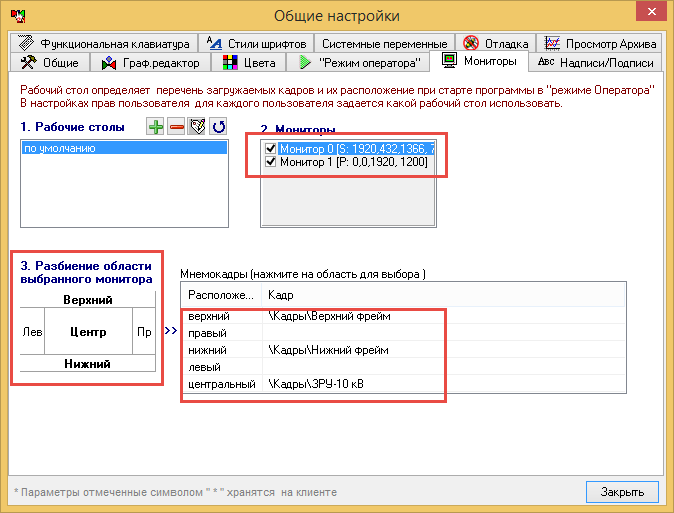
3. Is it possible to configure a trend from scripts: add feathers, set certain colors for them, etc.?
Нет, в настоящий момент возможность конфигурирования трендов из скриптов отсутствует. Стоит отметить, что работа с окнами трендов имеет некую интерактивность: можно перетаскивать в окно трендов мнемосимволы с кадров, можно запоминать добавленные пользователем перья. У мнемосимволов можно задавать рецептор, по которому будет открываться окно с заранее сконфигурированным набором перьев.
4. If the project has several almost identical mimic diagrams that differ only, for example, by numbers (one video frame is “Workshop 1” and it has valves valve1_11, valve1_22, valve1_33, valve1_44, the second video frame is “Workshop 8” and it has valves valve8_11, valve8_22, valve8_33, valve8_44) - is it possible to create a video frame / mnemonic template into which, at the lowest cost, substitute (in RUNTIME or during propagation in development mode) the necessary differences (prefixes / postfixes, etc.)?
It is possible to specify a template for a frame. The template is selected, again, from the list of frames. Moreover, the template will display both static elements and objects (mnemonic symbols, animators, receptors). Changes to this template will affect all frames where it is used.
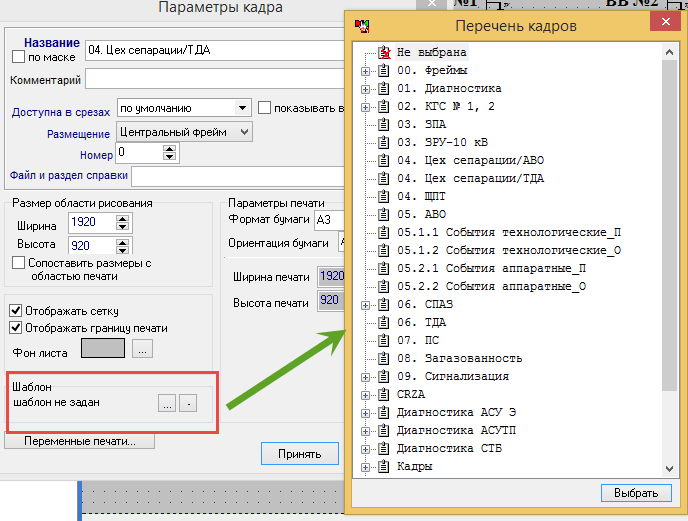
5. Running the operator workstation in RUNTIME - as in a demo project through a * .cmd file?
In the settings there is the option “Run in operator mode” (Component Manager - General Settings - General). If you set this option, the component manager will run in RunMode. The automatic start or restart of the component manager itself (as well as other SCADA components) can be arranged using the Application Monitor (АВШД.50014-05 31 01_ Application Monitor_OP_2015.pdf).
6. What is the concept of “cluster” in terms of SCADA TECON?
This term refers not so much to SCADA as to PTC as a whole. TEKON controllers can work in several modes:
- single CPU
- CPU redundancy
- CPU duplication
- controller duplication (cluster)
- CPU triplication
In this case, the cluster implies the use of a duplicated controller (a full copy of two controllers with USO modules). In this case, the signals are fed in parallel to both controllers. In SCADA, work with this pair of controllers is carried out, as with the usual single controller +, several additional services are implemented, such as signaling incomparison of values. This configuration is used for particularly demanding tasks, for example, a regulation system for turbine units or a TK system, PAZ power equipment.
7. Does SCADA TECON have the essence of “local variables” (variables that are not associated with I / O devices, but exist only within SCADA and used for)?
SCADA has the ability to use the ICORE core. The component is a computer core built into the server, like a controller. It can use both local variables and process any variables defined in the project (they are called external variables). The value of these variables will be the same on all clients. Also in scripts you can use the variables defined in the script. In this case, the processing of variables is performed on the client.
8. How to implement a client-server architecture? How to display on which video server the client is connected (primary, backup)?
Diagnostic frames are created by the user, using the mnemonic characters of the objects GATEWAY, CONTROLLER, COMPUTER.
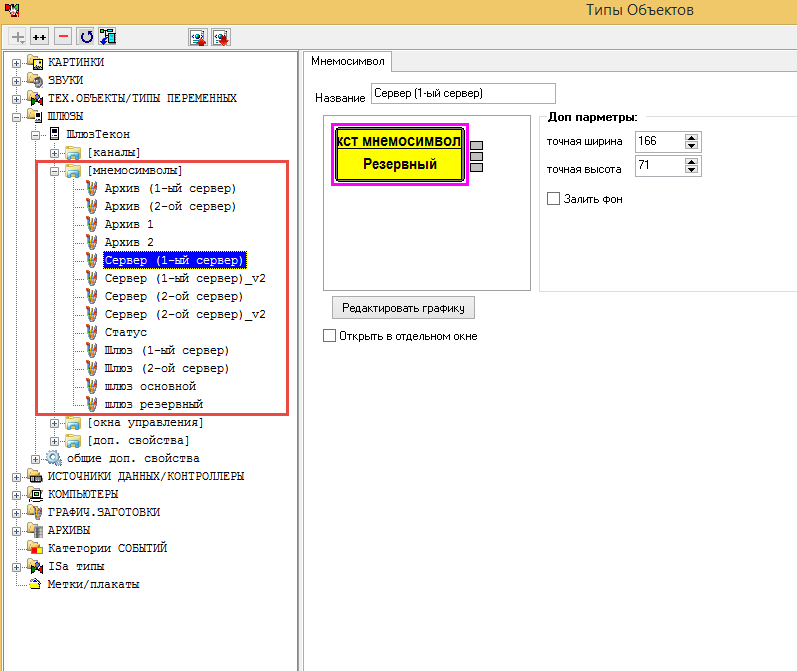
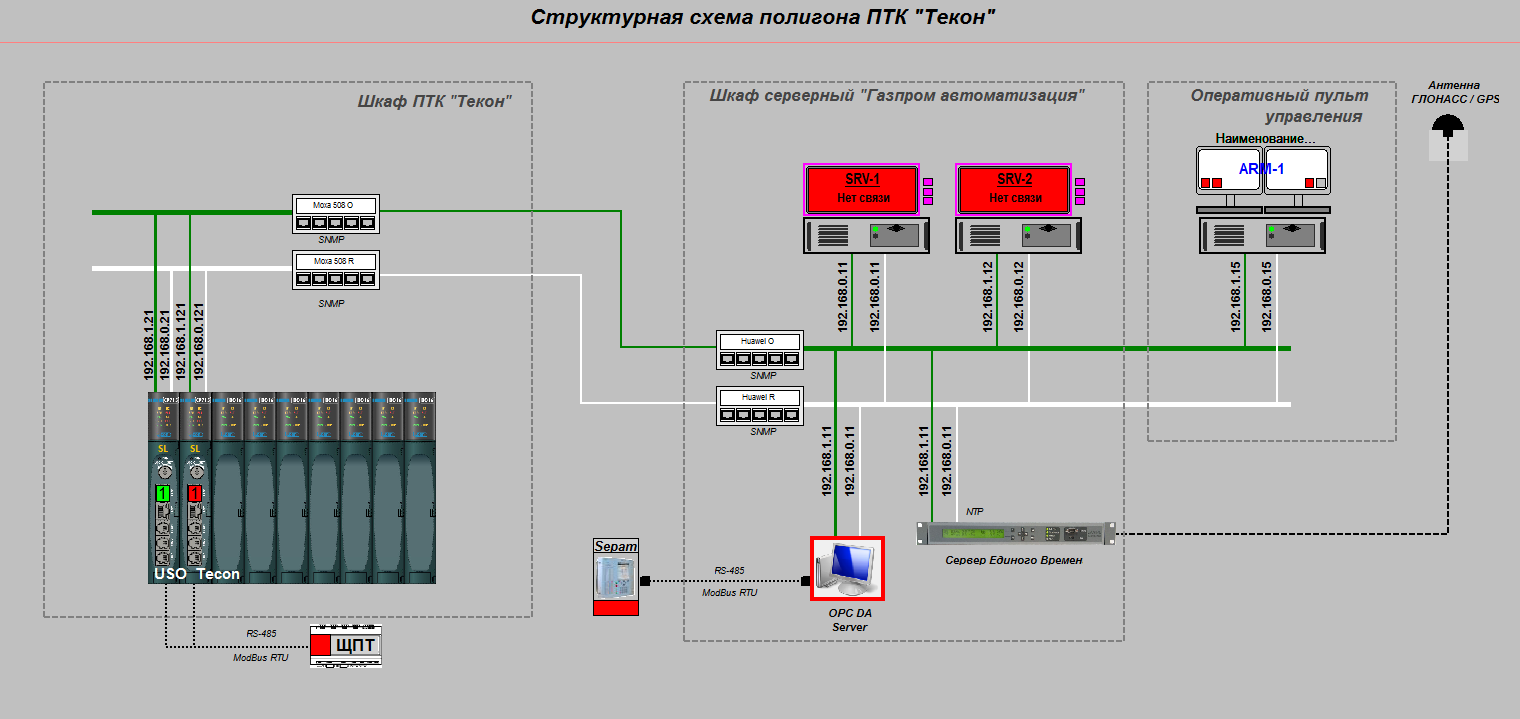
9. Is it possible to conduct development simultaneously from several PCs (for example, one draws mnemonic diagrams, the second makes tags)?
Yes, multi-user development is fully implemented. The main thing is to have access to the database server.
10. Are instances of library symbols “in touch” with their parents in the library (if you change the library mnemonic symbol, then its instances on the mnemonic circuit will pick up the change)?
Oh sure. After changing the mnemonic symbol, it is enough to rediscover the frame, or click the refresh page button.
For technological programs, a mechanism of templates and fixed templates is implemented. Fixed templates allow you to create sections of those. programs with variable templates. After being placed in those. program, changing the template updates all those. programs where this template is used.
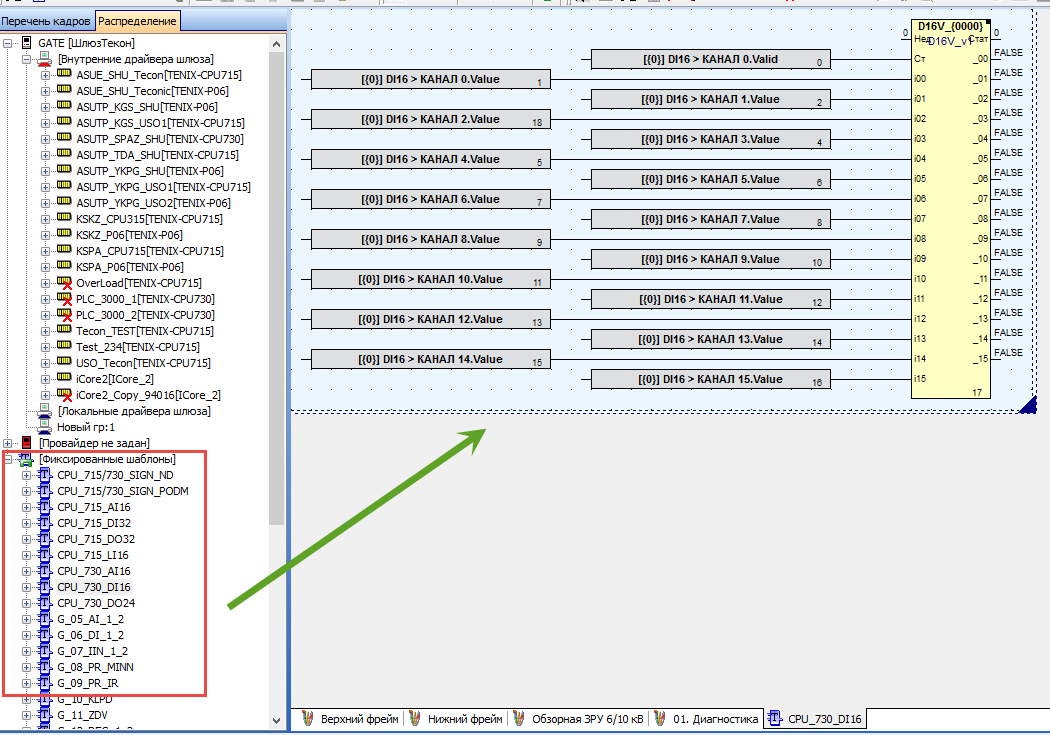
11. SCADA TEKON - is it a single environment for the development of the controller program and visualization on the workstation or does the controller need other software?
Yes, SCADA TEKON is a unified environment for developing a controller program and visualization on the workstation. Moreover, the same objects are used for programs and visualization, that is, there is no need to define objects twice and establish connections.
12. What animator can be used to implement the shift of a graphic element by several pixels depending on the value of the attached variable (for example, in the mnemonic symbol "switch" show the pumped out / pumped-in cart)?
We are currently implementing exactly this mechanism (exactly for the same task) at the request of one of the integrators. Functionality will appear in the next release.
PS The most difficult thing is to format the article on Habr ... :(
The developer requested to add that:
currently under development a new version of SCADA and a controller. SCADA will be fully cross-platform. PTK will be based on the concept of OPC UA.
